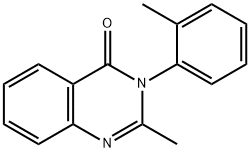METHAQUALONE
- CAS NO.:72-44-6
- Empirical Formula: C16H14N2O
- Molecular Weight: 250.3
- MDL number: MFCD00057320
- EINECS: 200-780-4
- SAFETY DATA SHEET (SDS)
- Update Date: 2024-12-18 14:08:57

What is METHAQUALONE?
Originator
Quaalude ,Lemmon,US,1965
The Uses of METHAQUALONE
A quinazoline sedative-hypnotic. Controlled substance.
Definition
ChEBI: Methaqualone is a member of the class of quinazolines that is quinazolin-4-one substituted at positions 2 and 3 by methyl and o-tolyl groups respectively. A depressant that increases the activity of the GABA receptors in the brain and nervous system, it is used as a sedative and hypnotic medication. It became popular as a recreational drug and club drug in the late 1960s and 1970s. It has a role as a GABA agonist and a sedative.
Manufacturing Process
Anthranilic acid (1 part) is dissolved in acetic anhydride (2 parts) and the temperature raised progressively to 190° to 200°C while distillation takes place. The last traces of acetic acid are removed under vacuum and, after cooling to about 50° to 60°C, o-toluidine (1 part) is added in portions.
The temperature is then raised to 170° to 200°C when the excess water and o-toluidine is gradually distilled off, finally maintaining the temperature at 180° to 200°C for 2 hours. After cooling to about 100°C dilute hydrochloric acid (3 parts) is added and the mixture boiled and stirred. The solution is then neutralized with NaOH with stirring and the product which separates is recrystallized twice from alcohol after decolorizing with carbon. Yield: 70% of theoretical, LIP 114° to 115°C.
brand name
Babix-rectal;Bon-sonnilal;Diudorm;Divinoctal;Dormisedilal;Duromine m 40;Isonox;Jurmun;Maoa;Melsedine base;Mepalgic;Mequal;Mequelon;Metadorm;Metakualon;Methadorm;Methaquaion;Methasedil;Metodril 2;Metodril napa;Neuro a2;Nitro-tromacardin;Nobadorm compostium;Noctulon;Normorest;Noxybel;Paldona;Pallidan;Papatral;Parmilene;Paxidorm;Pexaqualone;Portaderm;Pro dorm;Rebuso;Rectulon;Riporest;Rm 526;Rovonal;Savedorm;Sedalone;Sedanoct;Sedatyl;Silternum;Sleepinal;Somnex;Somnofac;Somnotropon;Soval;Sovelin;Sovinal;Spasmopront;Tiqualone;Toquilone;Toraflon;Toriador;Tualone;Tuazolona;Vitalone.
Therapeutic Function
Hypnotic
World Health Organization (WHO)
Methaqualone, a quinazolone derivative, was introduced in 1965 for use as a sedative-hypnotic drug. It is widely abused and is associated with severe withdrawal symptoms. Methaqualone is controlled under Schedule IV of the 1971 Convention of Psychotropic Substances. (Reference: (UNCPS4) United Nations Convention on Psychotropic Substances (IV),1971)
Properties of METHAQUALONE
| Melting point: | 120℃ |
| Boiling point: | 393.43°C (rough estimate) |
| Density | 1.16±0.1 g/cm3 (20 ºC 760 Torr) |
| refractive index | 1.6240 (estimate) |
| Flash point: | 9℃ |
| storage temp. | −20°C |
| solubility | DMF: 20 mg/ml; DMSO: 20 mg/ml; Ethanol: 20 mg/ml; Ethanol:PBS(pH 7.2) (1:1): 0.5 mg/ml |
| form | A neat solid |
| pka | pKa 2.54(H2O,t undefined,I=0.1) (Uncertain) |
| Water Solubility | 299.9mg/L(23 ºC) |
| EPA Substance Registry System | 4(3H)-Quinazolinone, 2-methyl-3-(2-methylphenyl)- (72-44-6) |
Safety information for METHAQUALONE
| Signal word | Danger |
| Pictogram(s) |
 Flame Flammables GHS02  Skull and Crossbones Acute Toxicity GHS06  Health Hazard GHS08 |
| GHS Hazard Statements |
H225:Flammable liquids H370:Specific target organ toxicity, single exposure |
| Precautionary Statement Codes |
P210:Keep away from heat/sparks/open flames/hot surfaces. — No smoking. P260:Do not breathe dust/fume/gas/mist/vapours/spray. P280:Wear protective gloves/protective clothing/eye protection/face protection. P311:Call a POISON CENTER or doctor/physician. P301+P310:IF SWALLOWED: Immediately call a POISON CENTER or doctor/physician. |
Computed Descriptors for METHAQUALONE
New Products
Tert-butyl bis(2-chloroethyl)carbamate (S)-3-Aminobutanenitrile hydrochloride N-Boc-D-alaninol N-BOC-D/L-ALANINOL N-octanoyl benzotriazole 4-Hydrazinobenzoic acid 3,4-Dibenzyloxybenzaldehyde 3-Nitrobenzaldehyde 1,1’-CARBONYLDIIMIDAZOLE R-2-BENZYLOXY PROPIONIC ACID 1,1’-CARBONYLDI (1,2-4 TRIAZOLE) 4-HYDROXY BENZYL ALCOHOL 3-NITRO-2-METHYL ANILINE (2-Hydroxyphenyl)acetonitrile 5-BROMO-2CYANO PYRIDINE 5,6-Dimethoxyindanone 5-broMo-2-chloro-N-cyclopentylpyriMidin-4-aMine 2-(Cyanocyclohexyl)acetic acid 4-methoxy-3,5-dinitropyridine 2-aminopropyl benzoate hydrochloride 1-(4-(aminomethyl)benzyl)urea hydrochloride tert-butyl 4- (ureidomethyl)benzylcarbamate diethyl 2-(2-((tertbutoxycarbonyl)amino) ethyl)malonate Ethyl-2-chloro((4-methoxyphenyl)hydrazono)acetateRelated products of tetrahydrofuran
![3-(4-CHLORO-2-METHYLPHENYL)-2-([(2-METHOXYPHENYL)SULFANYL]METHYL)-4(3H)-QUINAZOLINONE](https://img.chemicalbook.in/StructureFile/ChemBookStructure3/GIF/CB9246126.gif)
![6-CHLORO-2-([(4-CHLOROPHENYL)SULFANYL]METHYL)-3-(2-METHYLPHENYL)-4(3H)-QUINAZOLINONE](https://img.chemicalbook.in/StructureFile/ChemBookStructure3/GIF/CB8393728.gif)

![6-CHLORO-2-([(2,5-DICHLOROPHENYL)SULFANYL]METHYL)-3-(2-METHYLPHENYL)-4(3H)-QUINAZOLINONE](https://img.chemicalbook.in/StructureFile/ChemBookStructure3/GIF/CB1683031.gif)
![2-[(BUTYLSULFANYL)METHYL]-6,8-DICHLORO-3-(2,6-DIMETHYLPHENYL)-4(3H)-QUINAZOLINONE](https://img.chemicalbook.in/StructureFile/ChemBookStructure3/GIF/CB5243369.gif)
![2-[(BENZYLSULFANYL)METHYL]-6,8-DICHLORO-3-(2,6-DIMETHYLPHENYL)-4(3H)-QUINAZOLINONE](https://img.chemicalbook.in/StructureFile/ChemBookStructure3/GIF/CB7776090.gif)
![6,8-DICHLORO-3-(2,6-DIMETHYLPHENYL)-2-(([3-(TRIFLUOROMETHYL)PHENYL]SULFANYL)METHYL)-4(3H)-QUINAZOLINONE](https://img.chemicalbook.in/StructureFile/ChemBookStructure3/GIF/CB4269582.gif)
![6-CHLORO-2-([(3-CHLOROPHENYL)SULFANYL]METHYL)-3-(2-METHYLPHENYL)-4(3H)-QUINAZOLINONE](https://img.chemicalbook.in/StructureFile/ChemBookStructure3/GIF/CB6212416.gif)
You may like
-
 873-83-6 6-Aminouracil (or) 4-Amino-2,6- dihydroxypyrimidine, (or) 6-Amino2,4-pyrimidinediol 99%View Details
873-83-6 6-Aminouracil (or) 4-Amino-2,6- dihydroxypyrimidine, (or) 6-Amino2,4-pyrimidinediol 99%View Details
873-83-6 -
 55441-95-7 99%View Details
55441-95-7 99%View Details
55441-95-7 -
 N-Vinylformamide 99%View Details
N-Vinylformamide 99%View Details
13162-05-5 -
 Chloro Uracil 1820-81-1 99%View Details
Chloro Uracil 1820-81-1 99%View Details
1820-81-1 -
 207557-35-5 99%View Details
207557-35-5 99%View Details
207557-35-5 -
 2-ethyl-6-methyl-3-hydroxypyridine succinate 99%View Details
2-ethyl-6-methyl-3-hydroxypyridine succinate 99%View Details
127464-43-1 -
 2-ETHYLPYRIDINE 100-71-0 99%View Details
2-ETHYLPYRIDINE 100-71-0 99%View Details
100-71-0 -
 181228-33-1 (S)-Methyl 3-amino-2-((tert-butoxycarbonyl)amino)propanote Hydrochloride (DAP-OMe. HCl) 99%View Details
181228-33-1 (S)-Methyl 3-amino-2-((tert-butoxycarbonyl)amino)propanote Hydrochloride (DAP-OMe. HCl) 99%View Details
181228-33-1